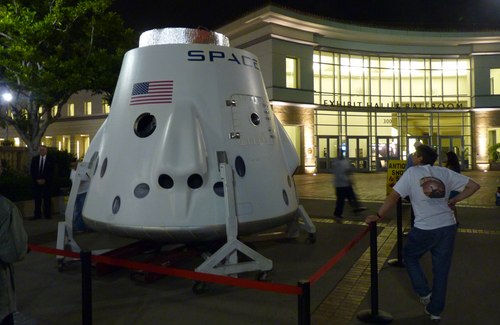
A mockup of the crewed version of the Dragon spacecraft on display Friday night outside the Pasadena Convention Center, which is hosting The Planetary Society’s PlanetFest and The Mars Society’s annual conference this weekend. (credit: J. Foust)
[ First in a series of posts about the companies that won and lost in NASA’s Commercial Crew Integrated Capability (CCiCap) competition ]
Of all the companies involved in the CCiCap competition, SpaceX was widely considered to have an inside track to win one of the awards. Just over two months ago it successfully demonstrated its ability to deliver cargo to the International Space Station using its Falcon 9 rocket and Dragon spacecraft, vehicles that would be used, with upgrades and safety improvements, to ferry astronauts as well. So did that explain why SpaceX CEO Elon Musk sounded relatively restrained on a conference call with reporters Friday morning, after the awards were announced?
No. Instead, he was simply a little tired. “I’ve actually just gotten very little sleep because I was quite keen to hear the announcement this morning, so I only got a few hours of sleep,” he explained. (The announcement of the CCiCap awards was made at 6 am Pacific time.) “I’m actually super excited about it.”
The SpaceX CCiCap award includes 14 milestones, though critical design review, with a total value of $440 million. Those milestones include a pad abort test of the Dragon’s escape thrusters, as well as an in-flight abort test, where the Dragon uses its thrusters to escape from its Falcon 9 launcher during ascent. Both of those tests are slated to take place from the SpaceX launch site at Cape Canaveral, although Musk suggested in the telecon that at least the pad abort test could take place elsewhere as a safety issue.
Musk said he believed that SpaceX has an advantage over Boeing and Sierra Nevada because of the company’s long-term vision of putting people into space. “Human spaceflight has been the goal of SpaceX since the beginning, so the way we’ve designed the Falcon 9 and Dragon is to comply as best we can with the NASA human rating requirements,” he said. “If someone were to stow away on the cargo version of Dragon, they would have actually been fine on the last mission.”
Musk played up the economic benefits the company could provide to Florida, envisioning 1,000 jobs at its Cape Canaveral launch site within four to five years, plus several times that in indirect jobs linked to those activities. He said SpaceX would put “hundreds of millions of dollars” of its own money into the crew development project, which he estimates will have an overall cost of about $1 billion.
“It should make for some really exciting stuff for the American space program in the years ahead,” he said at the end of the brief conference call. “We look forward to doing a good job for NASA and the American people and scoring a few goals for the home team here.”

Leave a Reply